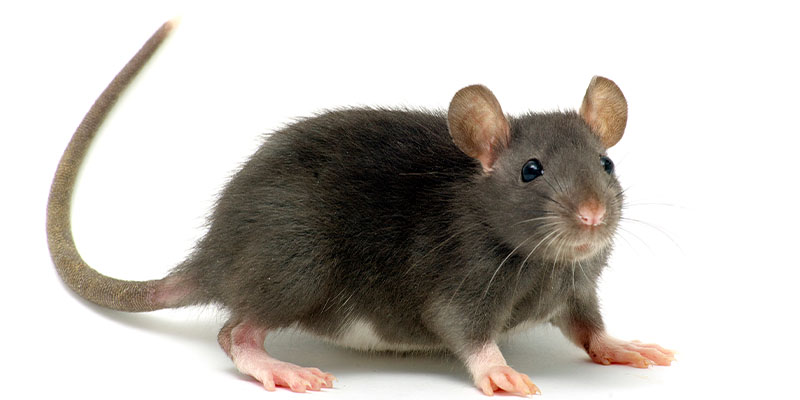Roof rats (Rattus rattus), also known as black rats or ship rats, are common rodent pests that can cause significant problems for homeowners. Distinguished from other rat species by their slender bodies, long tails, and agile climbing abilities, roof rats are notorious for their ability to infest residential homes and cause damage.
Learning about roof rats, their attractions, entry points, potential dangers, preventive measures, and effective eradication methods is essential for homeowners to protect their properties from these unwanted invaders.
So, What are Roof Rats?
Roof rats are medium-sized rodents, typically measuring between 12 to 16 inches (30 to 40 cm) in length, including their long tails. They have sleek, dark-colored fur and large ears. Unlike Norway rats, another common rat species, roof rats have tails that are longer than their bodies. As their name suggests, roof rats are adept climbers, often seeking shelter in higher places, such as attics, rafters, and tree branches.
How Roof Rats Differ from Other Rat Species
Roof rats can be distinguished from other rat species by their physical characteristics and habits. Compared to Norway rats, roof rats have darker fur, more slender bodies, and tails that are longer than their heads and bodies combined. Roof rats are also more agile climbers, often using overhead utility lines and tree branches to access buildings.
Biggest Attraction Factors for Roof Rats
Just like a lot of other pests and rodent species, roof rats are attracted to residential homes due to several factors, including the following:
- Food sources. Roof rats are omnivores and will consume a wide variety of food items. They are particularly drawn to fruits, vegetables, grains, pet food, and birdseed left in open containers.
- Water. Roof rats require a constant water source, making properties with accessible water attractive to these rodents.
- Shelter. Homes with clutter, overgrown vegetation, and openings in roofs or walls provide ideal shelter for roof rats.
You’ve probably noticed if you’ve done even a modicum of research, these three necessities are the biggest attractors to not only roof rats, but other rodents, insects, and every other pest. Food, water, and shelter are necessary for every living creature, and roof rats are no exception.
Entry Points for Roof Rats
Roof rats can get into homes through very small openings. They can fit through holes as small as 1/4 inch in diameter. Roof rats will also chew through wood, plastic, and other materials to get into homes. Plus, since roof rats are excellent climbers, they can easily access homes through various entry points, including:
- Roof vents. Roof rats can enter through roof vents, especially if they are not adequately screened.
- Tree branches. Overhanging tree branches and utility lines can provide direct access to roofs and attics.
- Gaps and cracks. Roof rats can squeeze through small gaps and cracks in walls, foundations, and eaves.
In other words, if something provides a direct line into a household, these rodents will exploit that particular avenue to their advantage and enter into a residential home, usually undetected.
Dangers Posed by Roof Rats
Roof rats are not only gross, but they can also pose several dangers to homeowners in a few very disturbing ways:
- Property damage. Roof rats can gnaw on electrical wires, insulation, and structural materials, leading to potential fire hazards and costly repairs.
- Disease transmission. Like all rodents, roof rats can carry and transmit diseases to humans through their droppings and urine.
- Contamination. Roof rats can contaminate food and surfaces with their droppings, posing health risks to residents.
In addition to these, roof rats can carry fleas into a home. Because fleas live on warm-blooded creatures, infested rats can bring fleas right into a house.
Preventive Measures Homeowners Can Use
So, if these pests are so adept at getting into homes, how do you stop them? Well, to prevent roof rats from entering your home, consider implementing the following measures:
- Seal entry points. Inspect your home for gaps and cracks and seal them with durable materials like steel wool or caulk.
- Trim trees and vegetation. Trim branches away from your home’s roof to prevent easy access for roof rats.
- Secure food and water sources. Store food in airtight containers and clean up spills promptly. Fix any leaks and remove standing water around your property.
Basically, carefully evaluate your property and address anything that would attract roof rats and/or give them free access to your house. You should revisit these things periodically, too.
Eradication of Roof Rat Infestations
Now, if you are unfortunate enough to discover a roof rat infestation in your home, taking prompt action is essential. You can do the following to get rid of these dirty and destructive rodents:
- Trapping. Set up snap traps or live traps baited with peanut butter, dried fruits, or nuts to capture roof rats.
- Rodenticides. Use rodenticides as a last resort, and always follow the manufacturer’s instructions carefully. Be cautious if using them in homes with pets or children.
- Professional pest control. If the infestation is severe or your efforts are not effective, consult a professional pest control service experienced in dealing with roof rats.
If traps and rodenticides don’t seem to curtail the problem, you’ll need professional help to get them out of your home and keep them out. Simply repeating the process won’t be enough.
The Bottom Line
Roof rats are resourceful rodents known for their climbing abilities and ability to infiltrate residential homes. Understanding their attractions, entry points, potential dangers, preventive measures, and eradication strategies is crucial for homeowners to safeguard their properties from roof rat infestations. By addressing vulnerabilities and implementing proactive measures, homeowners can protect their homes from these pesky pests and maintain a safe and rodent-free living environment.

